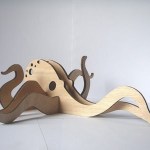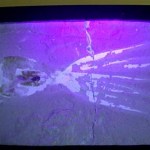cephalopod
Stunning footage of deep-sea squids from the Monterey Bay Aquarium Research Institute (MBARI), where researchers use remotely operated vehicles (ROVs) to observe and record deep-sea animal behaviors.
If for no other reason, I love the American Museum of Natural History because it contains a web of seemingly endless nooks and crannies to explore. One, just far enough away from the main exhibit halls to go unnoticed by most visitors (it is not even denoted on the museum map anymore), is a collection of seashells from a time when neatly-arrayed collections of specimens set in place next to their identification labels formed the core of natural history museums. Most are relatively familiar, curled houses without their occupants, but there is one which immediately grabbed my attention the…
So a week back or so, a number of friends read an article about death by rectal eel and immediately thought of me. For those of you who missed the story, it went a little something like this:
* Chinese man gets drunk with friends and passes out
* Friends think it would be hilarious to insert a large living swamp eel into the man's butt while he is unconscious
* Hilarity does not ensue. In fact, the man dies. Chinese doctor says the eel "consumed the man's bowels"
The article was widely reported in major news outlets like CNN and the Times, but I am linking instead to the UK edition of…
A research team led by Julian Finn of the Museum of Victoria in Melbourne has discovered octopuses using coconut shells as portable protection. Not only do they hide under single halves but will actually pull two halves together and hide inside, like some sort of Super Mario baddie. The video is remarkable.
Using tools means octopuses now join an elite club of wise animals including chimps, dolphins, and Tim Allen.
Thanks to Salem for sending this along.
One of the sucky things about viral interest in offbeat art from small vendors is that it always immediately depletes the supply. Like this fabulous minimalist plywood octopus from inthewoods' etsy shop. Sure, you can still get a plywood squirrel with a plywood acorn, but where's the sinister, feverish Cthulhulian majesty in that? Frustrated now!
Via monoscope
by Katie the lowly intern
Just when you started to feel comforted by the surge of popular culture embracing cephalopods on TV, apparel and porn, scientists spoon out a dose of brutal reality. Researchers from University of Melbourne, University of Brussels and Museum Victoria have revealed another terrifying fact about octopuses. It's not enough that they can squirt ink, have beaks, move by jet propulsion, change colors in seconds, turn their eyes to keep their pupils horizontally oriented, have no bones and most horrifically: have eight arms... but give very few hugs*.
The original octo-…
As boneless, gelatinous bags, octopuses rarely find themselves preserved as fossils but just this week it was announced in the journal Palaeontology that three new 95,000,000 year old octopus fossils have been discovered. These are the oldest on record. So what does an octopus fossil look like? Apparently, like something your elementary school child would create in art class when asked to create an octopus fossil.
The precursors to modern octopuses had fins that ran alongside their bodies but these fossils do not. "These are sensational fossils, extraordinarily well preserved' says Dirk…
Our friends at the New England Aquarium pointed us to these nifty shots of their giant Pacific octopus squeezing itself into a small acrylic box for some delicious crab.
As part of regular enrichment activities for the octopus, aquarist Bill Murphy hides food in plastic boxes with different types of "locks" the octopus must figure out. In this case, the box being used had a hole in it created by the aquarium's previous resident octopus and, rather than open the top, the octopus just sort of poured himself in. When the aquarium really wants to frustrate their octopus, they just give it a…
It's become something of a tradition here at ScienceBlogs to write series of posts that are published on Fridays. For example, Janet from Adventures in Ethics and Science writes Friday Sprog Blogging, a tribute to her inquisitive offspring, and Abel from Terra Sigillata has been known to author a Friday Fermentable series about his explorations into fine wine—he even brought the column to life during ScienceOnline'09. So we here at Seed thought it time to pay tribute to the efforts of these dedicated bloggers, as we too salute this glorious day.
Something Rich and Strange
Jessica Palmer, 2008
Merry Christmas and Happy Hanukkah from Bioephemera!
A big thank you to everyone who reads and comments on my blog - you are why I do this. Enjoy your holiday and have a wonderful New Year!
Jess
So I was showing Zooillogix to a few folks at my friend's party in San Francisco and this guy broke out this sweet dumbo octopus tattoo. I'll show you mine, if you show me yours can be a risky move for a straight guy in SF, but it worked out this time around.
Dumbo octopus action
He also had this spotted owl tat, which appears to be nesting in a dense thicket of some sort...
Thanks to Nicky Crane (not the deceased gay neo-Nazi skinhead activist) and Cassie Abel for providing the booze and camera.
Some times I find myself in random corners of the Interweb, pleasantly lost, and then I come face to face with the piglet squid!
Unaccustomed to Earth's atmosphere, the visitor quickly perished.
The following info is from a short press release provided by the Cabrillo Marine Aquarium when they found this little tyke.
Piglet Squid, Helicocranchia pfefferi
This funny looking squid is about the size of a small avocado and can be found most commonly in the deepwater (greater than 100 m or 320 ft) of virtually all oceans. Its habit of filling up with water and the funny location of its siphone…
Back in March of 2007, we brought you the story of an enormous (colossal really) squid, captured by New Zealandish fishermen and brought back for examination at the University of New Zealand. The frozen squid posed challenges for the researchers who realized that it would take so long to thaw that the outer parts would be rotting before the core had even melted (also an appropriate description of my brother Benny's heart).
Well the marine biologists made their move today, thawing out the colossal squid in a bath of cool water. Had the water been too hot, they were worried it might crack the…
So maybe it doesn't "terrorize" so much as it "fascinates" nerds like us, but nevertheless, a truly bizarre critter has emerged from the depths of the Pacific. Researchers at the Natural Energy Laboratory of Hawaii used a 3,000 foot hose to suck the hapless cephalopod up from the black depths off Keahole Point last week. The slippery subject, which may be an entirely new species, has the body of a squid but the eight suction-cupped arms of an octopus. Octosquid arrived at the surface alive because cephalopods' bag-like bodies naturally adjust to pressure changes. The two black ratfish that…
Fisherman hauled the world's largest squid ever caught out of the icy Antarctic waters last month. Since then, it has been kept on ice while scientists ponder how to prepare it for permanent display at the University of New Zealand. Larger than giant squid, colossal squid range from 40-65 feet long. This specimen weighed 1,090 lbs and was 33 feet long. Now the scientists have run into a problem: the frozen squid is so large that by the time the center of the beast defrosts, the outer flesh will have rotted.Colossal squid captured, mesonychoteuthis hamiltoni
The logical solution? Throw the…
You probably know octopuses can change their color and appearance but this footage is unbelievable. Before you harass me, it is "octopuses" and not "octopi."Disclaimer - actual adorable octopuses featured above may not berepresentative of much less adorable octopuses in video. Sepiadarium austrinum


